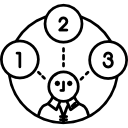Computational Thinking: Difference between revisions
(Created page with "right|frame|Computational thinking, problem-solving and programming<ref>http://www.flaticon.com/</ref> Wing (2006, 2011) defined computational think...") |
No edit summary |
||
| Line 1: | Line 1: | ||
[[file:computation.png|right|frame|Computational thinking, problem-solving and programming<ref>http://www.flaticon.com/</ref>]] | [[file:computation.png|right|frame|Computational thinking, problem-solving and programming<ref>http://www.flaticon.com/</ref>]] | ||
== Understandings == | == Understandings == | ||
| Line 11: | Line 5: | ||
Students must be able to explain (in the context of Computational thinking to analyse a given problem): | Students must be able to explain (in the context of Computational thinking to analyse a given problem): | ||
# Abstraction | # [[Abstraction]] | ||
# Decomposition | # [[Decomposition]] | ||
# Algorithms | # [[Algorithms]] | ||
# Pattern recognition | # [[Pattern recognition]] | ||
| Line 21: | Line 15: | ||
Students must be able to demonstrate: | Students must be able to demonstrate: | ||
# an | # an approach to any given problem from a computational thinking point of view. | ||
| Line 27: | Line 21: | ||
Students must be able to apply: | Students must be able to apply: | ||
# computational thinking to non-computer-based activities. | # computational thinking to non-computer-based activities. | ||
Revision as of 10:02, 4 December 2022

Understandings[edit]
Computational thinking (abbreviated to CT) is an analytical process that can be broken down into four elements: Abstraction; Decomposition; Algorithms; and Pattern recognition.
Students must be able to explain (in the context of Computational thinking to analyse a given problem):
Computational thinking is essential for the development of computational solutions which may or may not be computer-based.
Students must be able to demonstrate:
- an approach to any given problem from a computational thinking point of view.
Computational thinking is a problem-solving process used across multiple disciplines, and not just in computer science.
Students must be able to apply:
- computational thinking to non-computer-based activities.
Computational thinking includes algorithmic thinking. Algorithmic thinking is the basis of solving problems through developing algorithms.
Students must be able to construct:
algorithms that address a given problem and evaluate whether a given algorithm would solve a given problem.